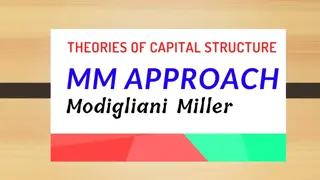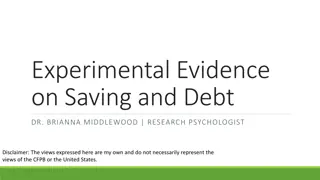Estimating Cost of Debt and Capital by Aswath Damodaran
This session by Aswath Damodaran focuses on estimating the cost of debt and capital for companies. It covers criteria for debt, estimating the cost of debt, synthetic ratings, interest coverage ratios, ratings and default spreads, and cost of debt computations with practical examples and strategies.
Download Presentation

Please find below an Image/Link to download the presentation.
The content on the website is provided AS IS for your information and personal use only. It may not be sold, licensed, or shared on other websites without obtaining consent from the author.If you encounter any issues during the download, it is possible that the publisher has removed the file from their server.
You are allowed to download the files provided on this website for personal or commercial use, subject to the condition that they are used lawfully. All files are the property of their respective owners.
The content on the website is provided AS IS for your information and personal use only. It may not be sold, licensed, or shared on other websites without obtaining consent from the author.
E N D
Presentation Transcript
Aswath Damodaran 1 SESSION 6: ESTIMATING COST OF DEBT, DEBT RATIOS AND COST OF CAPITAL #
Bringing debt into the capital equation 2 Aswath Damodaran 2
What is debt? 3 Criteria for debt Contractual commitment Usually tax deductible Failure to meet leads to loss of control. Meeting these criteria All interest bearing debt Lease commitments Questionable Accounts payable & supplier credit Under funded pension and health care obligations Aswath Damodaran 3
Estimating the Cost of Debt 4 Rate at which you can borrow money, long term & today. Easy cases Liquid, traded straight bonds outstanding: Yield to maturity. Bond Rating for company: Default spread for rating No bonds, no rating: Synthetic rating Aswath Damodaran 4
Estimating Synthetic Ratings 5 Simplest synthetic rating based on: Interest Coverage Ratio = EBIT / Interest Expenses For Embraer s interest coverage ratio, we used the interest expenses from 2003 and the average EBIT from 2001 to 2003. Interest Coverage Ratio = 462.1 /129.70 = 3.56 Aswath Damodaran 5
Interest Coverage Ratios, Ratings and Default Spreads: 2003 & 2004 6 If Interest Coverage Ratio is Estimated Bond Rating Spread(2004) > 8.50 (>12.50) 6.50 - 8.50 (9.5-12.5) AA 5.50 - 6.50 (7.5-9.5) A+ 4.25 - 5.50 (6-7.5) 3.00 - 4.25 (4.5-6) 2.50 - 3.00 (4-4.5) 2.25- 2.50 (3.5-4) 2.00 - 2.25 ((3-3.5) 1.75 - 2.00 (2.5-3) 1.50 - 1.75 (2-2.5) 1.25 - 1.50 (1.5-2) 0.80 - 1.25 (1.25-1.5) CCC 0.65 - 0.80 (0.8-1.25) CC 0.20 - 0.65 (0.5-0.8) C < 0.20 (<0.5) D Default Spread(2003) Default AAA 0.75% 1.00% 1.50% 1.80% 2.00% 2.25% 2.75% 3.50% 4.75% 6.50% 8.00% 10.00% 11.50% 12.70% 15.00% 0.35% 0.50% 0.70% 0.85% 1.00% 1.50% 2.00% 2.50% 3.25% 4.00% 6.00% 8.00% 10.00% 12.00% 20.00%. A A BBB BB+ BB B+ B B Aswath Damodaran 6
Cost of Debt computations 7 In general: Pre-tax cost of debt = Risk free rate + Default spread With companies in risky (default) countries: Pre-tax cost of debt = Risk free rate + Company Default Spread + Country Default Spread Embraer s cost of debt in 2004 = Riskfree rate + 2/3 (Brazil default spread) + Embraer default spread =4.29% + 2/3 (6%) + 1.00% = 9.29% Aswath Damodaran 7
Weights for the Cost of Capital Computation 8 Use market value weights. Not Reasons Not because market is right Not because market values are easier to get Real reason Cost of acquiring company today Aswath Damodaran 8
Getting a market value for debt: Disney 9 In 2013, Disney s pre-tax cost of debt was 3.75%. To get the market value of interest bearing debt, act as if you are pricing a bond: 1 (1- Estimated MV of Disney Debt = 14,288 (1.0375)7.92=$13,028 million (1.0375)7.92 .0375 + 349 To convert leases into debt, you take the PV of lease commitments in the future @3.75% Year Commitment Present Value @3.75% 1 $507.00 2 $422.00 3 $342.00 4 $272.00 5 $217.00 6-10 $356.80 $1,330.69 Debt value of leases Disney reported $1,784 million in commitments after year 5. Given that their average commitment over the first 5 years, we assumed 5 years @ $356.8 million each. $488.67 $392.05 $306.24 $234.76 $180.52 $2,932.93 Aswath Damodaran 9
Estimating Cost of Capital: Embraer in 2004 10 Equity Cost of Equity = 4.29% + 1.07 (4%) + 0.27 (7.89%) = 10.70% Market Value of Equity =11,042 million BR ($ 3,781 million) Debt Cost of debt = 4.29% + 4.00% +1.00%= 9.29% Market Value of Debt = 2,083 million BR ($713 million) Cost of Capital Cost of Capital = 10.70 % (.84) + 9.29% (1- .34) (0.16)) = 9.97% Computing Market Value of debt Book Value = $1,953 m, Interest Expense = $222 m, Maturity = 4 years Market Value = 222 million (PV of annuity, 4 years, 9.29%) + $1,953 million/1.09294 = 2,083 million BR Aswath Damodaran 10
If you had to do it.Converting a Dollar Cost of Capital to a Nominal Real Cost of Capital 11 Approach 1: Use $R risk free rate and given inputs. Cost of Equity = 12% + 1.07(4%) + 27 (7. %) = 18.41% Cost of Debt = 12% + 1% = 13% Cost of Capital = 18.41% (.84) + 13%(1-.34)(.16) =16.84% Approach 2: Use the differential inflation rate to estimate the cost of capital. Ifthe inflation rate in BR is 8% and the inflation rate in the U.S. is 2%: Cost of capital= = 1.0997 (1.08/1.02)-1 = 0.1644 or 16.44% (1+Cost of Capital$)1+InflationBR 1+Inflation$ Aswath Damodaran 11
Dealing with Hybrids and Preferred Stock 12 With convertibles: Break down hybrids into debt and equity components. With preferred stock: Keep as separate capital source, with yield as cost. Aswath Damodaran 12
Recapping the Cost of Capital 13 Aswath Damodaran 13























